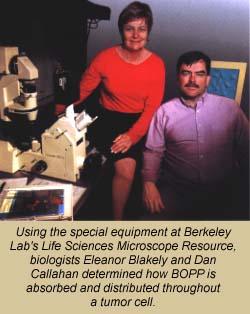
- A PRESCRIPTION FOR HOPE PART 5 -
 A BNCT
facility at Berkeley Lab with its ESQ-accelerator would be established
specifically for clinical tests of BOPP and other new
"second-generation" boronated compounds. The facility could also be
used to test compounds that concentrate in other types of tumors, such
as melanoma, sarcoma, head, neck, and pancreas tumors. FDA approval of
second-generation boronated compounds will be required before clinical
trials can begin. Working to provide the information on cytotoxicity
and pharmacokinetics needed by the FDA are Berkeley Lab biologists
Eleanor Blakely and Dan Callahan.
A BNCT
facility at Berkeley Lab with its ESQ-accelerator would be established
specifically for clinical tests of BOPP and other new
"second-generation" boronated compounds. The facility could also be
used to test compounds that concentrate in other types of tumors, such
as melanoma, sarcoma, head, neck, and pancreas tumors. FDA approval of
second-generation boronated compounds will be required before clinical
trials can begin. Working to provide the information on cytotoxicity
and pharmacokinetics needed by the FDA are Berkeley Lab biologists
Eleanor Blakely and Dan Callahan.
Among the accomplishments to date with BOPP has been the identification of the binding sites where it is taken into glioblastoma multiforme tumors, and the determination of how it gets distributed throughout the tumor cell. This has led to knowledge that eventually could help improve BOPPs effectiveness against the cancer.
Many porphyrins are known to be taken into cells through the same receptors that are used to take in low density lipoprotein (LDL). Using the specially adapted equipment at the Life Sciences Microscope Resource, Blakely and Callahan are providing evidence that the uptake of BOPP into brain cell tumors is likewise strongly dependent upon the presence of LDL-receptors. They are now working with Dr. Trudy Forte of Berkeley Lab, and Dr. Dennis Deen, associate director of UCSFs Brain Tumor Research Center, to verify whether or not glioblastoma multiforme tumors have an abnormally high number of LDL-receptors. If this proves to be the case, it would not only explain BOPPs preference for tumors, it also opens the door to a safer and more effective cancer treatment.
Says Blakely, "Knowing the mechanism behind the uptake of boron-laden compounds allows us the possibility of temporarily manipulating lipoprotein profiles in individual patients to further optimize the therapy."
So far, Blakely and Callahan have been working with cells in culture. At Berkeley Labs Center for Functional Imaging, other researchers, under the leadership of Dr. Thomas Budinger, are now developing protocols by which the uptake, clearance, and metabolic fate of BOPP and other proposed BNCT compounds could be monitored in animal models and human patients. Dr. James ONeil and Dr. Scott Taylor have already radiolabeled BOPP with copper-64 and have followed its biodistribution at the Centers Positron Emission Tomography facility, which features the worlds highest resolution PET scanner.
If everything continues to proceed on schedule, accelerator-based BNCT clinical trials could begin at Berkeley Lab as early as 1999. The talent pool that will make this happen is wide and diverse. At Berkeley Lab, this talent pool is primarily being drawn from LSD, AFRD, the Engineering Division (ED), and the Nuclear Science Division (NSD). In addition to those already named, other Berkeley Lab researchers making important contributions to the BNCT proposal are Javed Afzal from LSD; Rick Gough, Enrique Henestroza, Ka-Ngo Leung, John Staples, Bob Stevenson, and Simon Yu from AFRD; Matt Hoff, Craig Peters, Lou Reginato, and R.P. Singh from ED; and NSDs Gordon Wozniak.
Other leading collaborators from outside Berkeley Lab include Mitch Berger, Joseph Castro, John Fike, Dave Larson, Mike Prados, and Lynn Verhey from UCSF; and Richard Hoppe at Stanford University. Berger is the chair of UCSFs Neurological Surgery Depart-ment and director of the Brain Tumor Research Center; Hoppe chairs the Radiation Oncology Depart-ment at Stanford.
This partnering of nuclear and biological sciences with accelerator physics and engineering would be an astonishing achievement just about anywhere else except at Berkeley Lab. Here, it is in keeping with a tradition that stems back to Laboratorys earliest days when founder Ernest O. Lawrence, the accelerator physicist, was joined by his physician brother John. Together, the two of them, along with their colleagues, invented the field of nuclear medicine. Now, as we stand at the brink of the next millennium, this traditional partnership could move one of the twentieth centurys most deadly forms of cancer into the column of diseases marked "treatable."
